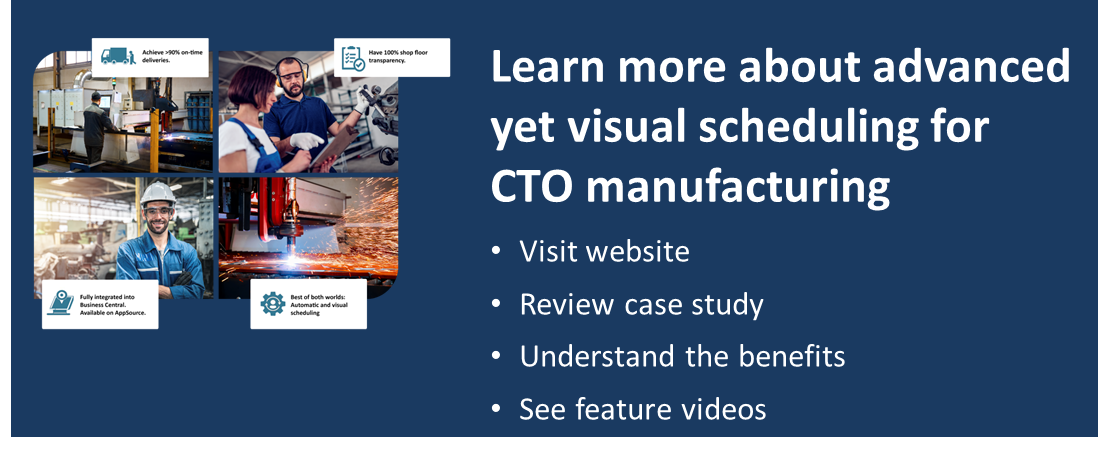Establishing configure-to-order (CTO) manufacturing processes is tempting. It promises the efficiency and scale effects of standardized (mass) production. Likewise, it pledges the flexibility and customer intimacy of a make-to-order manufacturer. However, theory and practice are two different things. I have met many configure-to-order manufacturers needing help to unleash the expected efficiency gains. Instead, they fight with ambitious customer deadlines and the mere complexity of their (semi-standardized) sub-assembly structures.
The obvious indication of this complexity is the sheer number of items and item variants in their ERP system. Combined with a multi-level bill-of-materials (BOM), this frequently leads to statements such as "we suffer from data ambiguity and fly blind when it comes to an understanding of the impacts of changes in our schedule."
This blog post describes why production scheduling is that hard and specific for configure-to-order manufacturers. Then, it provides production scheduling 101 for configure-to-order manufacturing and gives some ideas on how CTO manufacturers could tackle this challenge - especially when they work with Microsoft Dynamics 365 Business Central.
What is configure-to-order manufacturing?
 Configure-to-order manufacturing is when manufacturers customize a product to meet customers' needs or requirements. The manufacturing process typically involves configuring or assembling a custom product using a set of options or components pre-produced by the manufacturer. Customers can specify the exact configuration they want, and the manufacturer builds the product to meet those specifications. CTO differs from make-to-order (MTO) manufacturing, which creates a product from scratch specifically for a customer based on their unique specifications, and make-to-stock (MTS) manufacturing, in which products are manufactured and kept in inventory for customers to purchase.
Configure-to-order manufacturing is when manufacturers customize a product to meet customers' needs or requirements. The manufacturing process typically involves configuring or assembling a custom product using a set of options or components pre-produced by the manufacturer. Customers can specify the exact configuration they want, and the manufacturer builds the product to meet those specifications. CTO differs from make-to-order (MTO) manufacturing, which creates a product from scratch specifically for a customer based on their unique specifications, and make-to-stock (MTS) manufacturing, in which products are manufactured and kept in inventory for customers to purchase.
What are specific configure-to-order manufacturing challenges?
There are several challenges that manufacturers face when implementing a configure-to-order (CTO) manufacturing process, including:
- The complexity of product configuration: CTO manufacturing involves a high degree of product customization. This can make it challenging to manage the many options, the thus needed (standard) components, and their respective availability. The unwanted result of this level of complexity can be longer lead times and higher costs.
- Managing customer expectations: CTO manufacturing requires a high degree of communication between the manufacturer and the customer to ensure that the final product meets their expectations. These expectations, however, are not limited to technical specifications and quality. They also include delivery times, which lead to the next challenge.
- Meeting delivery deadlines: CTO manufacturers must juggle the production of the components and the assembly of the final deliveries. Delivery times hence are determined by the finite capacity of the machine job, the fluctuating capacity of the assembly teams, and the material availability. The entire picture is challenging to oversee. Hence, making firm delivery time commitments is an arduous task.
- Managing inventory: CTO manufacturing requires manufacturers to keep track of many components and options, which can be challenging to manage and lead to higher inventory costs.
- Quality control: CTO manufacturing often involves high customization of products, making ensuring consistent quality across different configurations difficult.
- IT systems: CTO manufacturing requires sophisticated IT systems to manage the product configuration process and accurately track orders, inventory, and production status.
What is production planning and scheduling?
People often use words like "planning" and "scheduling" as synonyms. However, they are different sides of the same coin. Thus, I'd like to point out what the difference is (and why that difference is so significant).
Planning focuses on what to make, roughly when, and where to make it in some applications. It combines the general sales plan (or the demand forecast) with production capabilities. Planning works in "buckets" of time (e.g., months or weeks). Planning is more rough-cut, and it has to be. It frequently works with the assumption of infinite capacity. This assumption helps companies to spot areas needing an increase in capacity. Thus, planning processes can result in companies making changes to their capacity. They want to make sure that they can - on average! - build to the projected demand.
Instead, scheduling defines the exact when and by whom to make it. Scheduling takes the planning output as input data. It then boils down the rough plan into a concrete production order and resource sequence. When scheduling, people decide when exactly and who exactly does a job. Scheduling puts the plan into action. It takes into account much more concrete restrictions than planning. It is much more short-term and much more tangible.
Scheduling has to recognize
- (finite) capacity,
- time constraints,
- delivery dates,
- or other restrictions, such as material availability.
In essence, production scheduling is production order and resource sequencing.
How can production scheduling help configure-to-order manufacturers?
Production scheduling can help configure-to-order (CTO) manufacturers in several ways:
- Meeting customer delivery deadlines: By accurately scheduling production and considering restrictions such as material availability and finite capacity, CTO manufacturers can make realistic delivery time commitments. Making better commitments increases the chance that products are completed and shipped to customers on time.
- Improved visibility: A well-managed schedule provides insights into each machine's and work center's timing and sequence of production orders. It also knows dependencies and hence facilitates what-if simulations. Furthermore, production scheduling can provide CTO manufacturers with real-time visibility into the production process, which can help identify bottlenecks and delays.
- Increasing resource usage: Production scheduling can help CTO manufacturers increase the use of their resources, such as labor and machines. The result is cost savings and reduced cycle times, increasing throughput.
- Improved inventory management: A material-centric production scheduling can help CTO manufacturers better manage inventory levels, which can reduce the costs associated with carrying excess inventory.
- Improved customer service: By meeting delivery deadlines and providing accurate lead times, CTO manufacturers can improve customer satisfaction and loyalty.
- Smooth execution of orders: Production scheduling can also help CTO manufacturers execute customer orders smoothly and efficiently by allocating resources in the best possible way, reducing lead time, and improving the overall customer experience.
- Flexibility: CTO manufacturers can use production schedules to balance the need for flexibility with meeting customer delivery deadlines and optimizing resource usage.
Specific scheduling challenges for configure-to-order manufacturing
The characteristics of a configure-to-order manufacturer and its specific challenges result in specific scheduling challenges that CTO manufacturers face.
Hybrid production process.
CTOs combine both: a typical machine shop and a labor-intense assembly process. The machine shop needs a scheduling system that works with a finite capacity of one. Whereas for the assembly process, they require a scheduling system that considers the limited but steadily fluctuating capacity resulting from the availability of their workers. To add complexity: the assembly tasks can often get accelerated by adding additional workers to them. And - marking an extra challenge for the scheduling approach: The demand dates for the machine shops often result from the due dates of the assembled goods.
Lead times and material availability.
CTO manufacturers must consider the lead times for each component and option when scheduling production. These lead times depend on external factors (suppliers' ability to deliver) and internal factors (the ability to produce the components needed for the final product). This task can be more complex than traditional scheduling as lead times for different options may vary widely. In addition, it is essential to understand the material availability quickly - both for the produced components and the assembled final deliveries. The scheduling system should work with material availability information as an integrated restriction.
Order tracking.
Ideally, CTO manufacturers have a system in place for tracking orders and updating the schedule as orders are received and changes happen. With such a system, they also can understand the entire supply/demand network and see which demand caused which supply.
Flexibility and transparency
Change is the only constant for many CTO manufacturers. Hence, they must be able to adapt their schedule quickly to changes in customer demand or unexpected events to avoid delays and keep the production line running smoothly. Changing the schedule requires a system that provides transparency and facilitates production schedule simulations. In case of unexpected events, planers must be able to make what-if simulations to understand the impact of planned or required schedule changes.
How does advanced yet visual scheduling for configure-to-order manufacturing work?
In a previous blog post, I outlined the meaning of visual scheduling with a focus on Microsoft Dynamics 365 Business Central: Visual scheduling is the process of visually scheduling with the help of dedicated scheduling tools and algorithms that are clear to the user.
As clarified before, the CTO production process is complex because of the many possible product configurations, making scheduling and production planning difficult.
Hence, advanced visual scheduling first breaks down the production process into smaller tasks or operations. Then it uses algorithms to effectively sequence these tasks on the given work and machine centers. These algorithms should consider the risk of being late for the final assembly processes and help minimize the time and resources required in the sub-assembly production.
Once the schedule (aka the production order sequence) is algorithmically determined, it should be visualized by production order Gantt charts and resource allocation diagrams.
Ideally, the visualization tools are not "read-only" but facilitate drag & drop changes by the user. However, when looking at the calculated schedule, experienced production planners always identify issues, conflicts, and areas to improve - based on their knowledge, experience, and some soft facts, which all cannot get programmed into the scheduling algorithm.
With drag & drop, and the capability to overrule the algorithm, production planners remain in the driver's seat and continue to own the plan.
This is what advanced yet visual scheduling can achieve for configure-to-order manufacturers. It allows for greater efficiency, improved delivery time commitments, reduced lead times, and better resource utilization, resulting in cost savings and improved customer satisfaction.
Your next steps
We created a website to show how configure-to-order manufacturers working with Microsoft Dynamics 365 Business Central can tackle their scheduling challenges. It comes with best practices, a video case study, references, and both benefits and feature videos.
You can get to this website by clicking the image below.


